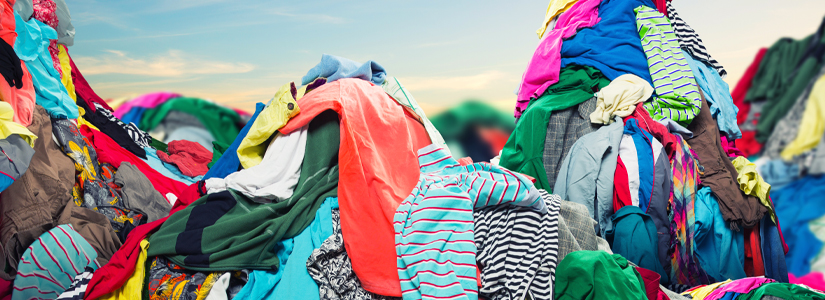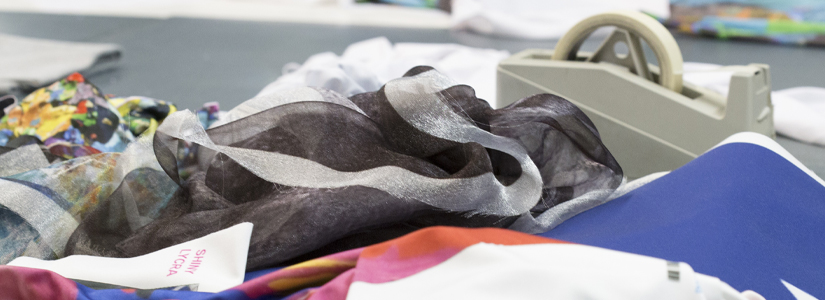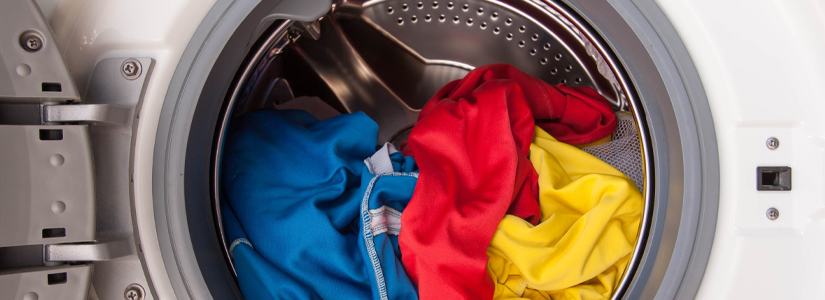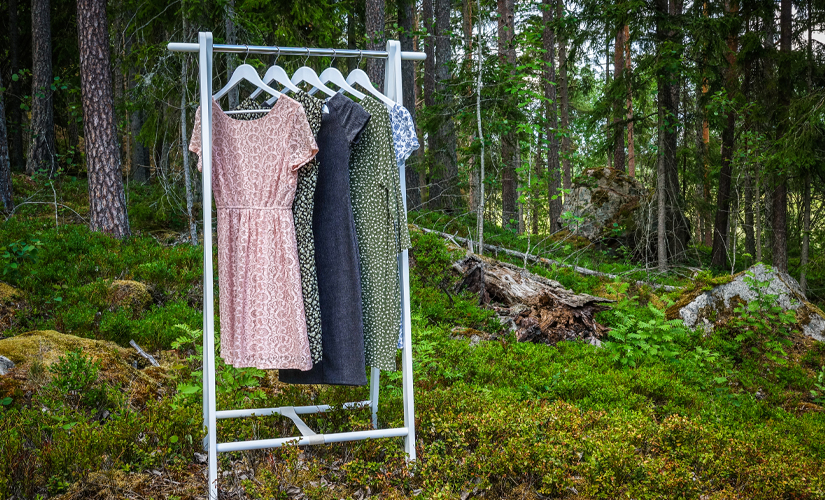What is sustainable fashion?
Sustainability has two different definitions. The first: the ability of phenomena to be maintained at a stable rate or level, and the second: the avoidance of the depletion of natural resources in order to maintain an ecological balance (according to Google dictionary). For our purposes, namely understanding sustainable fashion, we will refer to both definitions and consider their roles within the fashion industry.
Unfortunately, it doesn’t matter which way you slice it, fast fashion is not sustainable. At the moment on average in Australia, we dump 6000 kg of clothing and textile waste in landfill every ten minutes. The revolutionary ABC TV show “War on Waste” help us visualise this: check out the clothing pile dumped in the middle of Sydney’s Martin Place!
Why is sustainable fashion important?
The clothing and textile industry is the second largest polluter in the world, producing close to 20% of global waste.
Cotton, a natural material (imagine the impact of synthetics!), requires 20,000 litres of water to create one kilogram: the equivalent of a single T-shirt and pair of jeans. Around 95% of clothing waste that reaches landfill each year could be recycled, hence the modern call for sustainable fashion. If we recycled said one kilogram of cotton, that would save 20,000 litres of water alone.
These are staggering figures. If we adopt the circular fashion concept look this up!) and make sure that we take steps to be sustainable throughout the manufacturing process, then we maybe able to reduce these rates of pollution.

How Can the Fashion Industry be More Sustainable?
It Starts in The Sourcing
According to a report of 219 brands that Fashion Revolution published, 91% didn’t know where their cotton was grown. That’s pretty in-depth knowledge, but 75% didn’t even know where their fabrics were sourced. This equates to zero brand accountability, meaning the majority of retail companies can’t say with any degree of confidence the impact their sourcing is having on the environment.
At Contrado, we use locally sourced fabrics: we always make sure that we know where they are coming from. We stock a range of natural and organic fabrics, and even the wood that we use (eg. in canvas frames) is FSC certified. This knowledge and certification allows us to be fully informed and therefore consciously accountable for the impact our clothing production has on the planet.
Pretty Dress Version #103
At Contrado, we pride ourselves on using advanced technology to reduce our carbon footprint through offcuts. This happens throughout the design process, from designing on computers, to creating our samples in-house (including the use of in-house designers): this in itself means less waste from paper designs. We don’t print our samples, but instead use white fabric to make them; and where possible all amendments are made to the original prototype. We also use 3D rendering to give a more complete picture of the design. This also allows customers to see exactly what their garment will look like before they even place the order, resulting in a higher satisfaction rate as well as less reprinting.

Manufacturing – in the making
A staggering 50% of the brands in the Fashion Revolution survey not only didn’t know, but couldn’t trace accurately, where their products were cut and sewn. This isn’t pollution in the traditional sense of the word, but In fact, when considering the largest polluters in the world, the fashion industry is second only to the oil industry. It contributes around 10% of all global greenhouse gas production. This is before you take into account other environmental impacts like how cotton farms make up almost 50% of all irrigated land, 24% of insecticide use and 11% of all pesticide use. How almost 70% of rivers and lakes are contaminated, with more than 2.5 billion gallons of wastewater produced by the textile industry alone.
Most printing methods use water, and almost 20% of the water waste, globally, is produced by the fashion industry. The industry-wide ‘tolerated’ rate for fabric that is intended for clothing which ends up on the floor is 15% and has been for decades. Reports from the Environmental Protection Agency state that, in 2013, 15.1 million tons of textile waste was generated. Out of that 84.8% is discarded, which is 12.8 million tons.
When asking ‘What is sustainable fashion?’ to ourselves, we took all the above into consideration. This helped us to work towards a sustainable clothing model. We are heavily invested in sustainable fashion and textiles and will continue to do what we can for as long as it takes, and then longer.
We can 100% guarantee that we can trace where our clothing is cut and sewn. In fact, I could take a quick trip down a flight of stairs and see it happen for myself. We print on demand, here in our facility. We have a team of seamstresses, craftsmen, printing technicians and quality controllers who all work together to make sure everything is beautifully made in just a few days.
We use water-based inks to print, which are eco-friendly, and the specialist process that we use to print uses no water. This drastically reduces the amount of wastewater that we produce. This digital print method is dry instantly, so there are no intensive drying procedures either.
Due to the fact that everything is made on-demand, there is much less waste. As with any textile business, there will be fabric waste, however, what we do with it will determine if it’s helping what is sustainable fashion, or not. We bag these remnants up and offer them, for free, to our customers who fancy a little bit of a textile challenge.

Getting it on the shelves
The fashion industry has become more and more globalised over the last couple of decades. Even in the simplest setups, your clothing is likely to have been to at least three different countries, often continents. This supply chain would see the materials come from one place, the manufacturing in a second and sales in the third.
However, in recent years it has become not unusual for manufacturing to take place in a number of places itself. Printing in one facility, cutting in another, stitching in another and sometimes even embellishments in yet another, such as buttons and zips. It is also not uncommon to have the sales become multistep too if a distributor has ordered the clothing and is then supplying directly to a company, that would add yet another step. Often these transportations are done using cargo ships or planes, which produce huge amounts of pollution.
It’s not even just the clothing either, if you go into a shop, you also have point-of-sale, posters, signage and labelling. These change every season at the very least and also have to be produced, shipped and then disposed of as well, further adding to the problem that the fashion industry creates, without it even being caused by fashion so to speak.
Contrado decided to cut out the middleman. We have done this from the very start, as providing high-quality, handmade products is at the heart of everything we do. The foundations of the business model were set up to be a one-stop-shop, and that’s exactly how we intend for things to stay. After all, you can’t ask “what is sustainable fashion and how do we get on board?” and then take steps backwards.
We operate entirely online, which means all of our point of sale, our promotions and our posters are digital. This reduces the amount of waste from out of date offer posters, it reduces the amount of emissions that the people who make and deliver these marketing materials would produce, and it means that we can operate in a much cleaner, and more sustainable way.
Now it’s down to you, but we’re here to help
Even after a garment has been bought, there are ecological impacts, and those ones lie with you. Washing, drying, ironing, these all impact the environment. A brand new all-singing-all-dancing high-efficiency washing machine uses around 100 litres of water per load. This is a vast improvement on the 170 litres per load that some of the later models use, but it’s still a lot.
The average run-of-the-mill tumble dryer (which the majority of houses have in Australia) will produce around 1.8 kg of CO2 per cycle, and millions of households will use electric tumble dryers to dry their laundry.
Washing a load of laundry at 60° in a combined washer-dryer produces on average 3.3kg of CO2 or alternative greenhouse gases as a CO2 equivalent, compared to just 0.6kg for a load washed at 30° and line-dried outside.
As we said, this part is down to you. But we can’t help but do what we can to help you. Many of the materials that we source are low-crease or wrinkle-free. Our designers make sure that the right fabrics are used for the right garments so that they naturally take the shape that they are intended to. The majority of our fabrics can be washed on a 30° cycle, so there’s no need to hot wash them, and nearly every fabric, if not all of them, will hang dry nicely.

Getting it off the shelves
It’s not just the clothing that you buy that contributes to a bigger carbon footprint either. If we’re totally honest it’s probably not even the worst. What also causes huge environmental impacts is the stock that doesn’t sell. The thing about mass production is its pretty much entirely guesswork; how many of each size is required? How many of each colour? So many questions. With fast fashion becoming more and more popular there is no time to manufacture dependant on what sells and what doesn’t because by the time the first lot has been shipped out, has hit stores and has started to sell out, there is no requirement for any more. Everyone is already onto the next new trend by then.
Some of the big-name brands, especially the ones that have an air of exclusivity to them, tend to burn their stock, to stop the market becoming oversaturated and reducing their uniqueness and exclusivity. I think it goes without saying that setting a giant fire and burning a bunch of textiles, is not good for the environment at all.
Contrado is a print on demand company. Pretty much every piece of clothing we sell isn’t even clothing yet. Currently, it is just rolls and rolls of plain white fabric, sitting on a shelf, waiting to be given a lease of life. It is only printed with your stunning designs once you’ve placed the order. Then cut, and then stitched together to make your garment. Due to this, there won’t ever be any stock left over, pre-printed and pre-made in a size that nobody wants, so we have nothing to burn
Up and at ‘em!
So why, you ask, is sustainable fashion a superhero shopping concept? Well, we’ve looked at “what is sustainable fashion?” and we have also looked at the huge impact that fast fashion is having on the world around us.
Sustainable fashion is the way forward. It’s the Batman that wants to protect his city. It’s the Stark Industries that made all the technological advancements to make money, and then realised what it was doing to the world. The Tony Stark who started applying his know-how to make things better. It’s the Peter Parker who knows that with great power comes great responsibility. Well, we think you get the picture…



